TA41E - Easington seaside
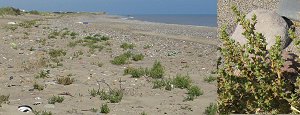
This is tetrad is reduced to about 40% land area by shoreline. It has small areas of different broad habitats including village urban spaces and walls, grassy cliff-top communities, hedgerow with tall-herb communities, maintained amenity grassland, road verge, arable margin and disturbed soil. Surveys of these areas in July yielded 140 taxa. A long-established sea defence wall and a yellow and grey dune surrounding Easington Lagoon SSSI were visited by Richard and I on 3 September when we were delighted to find a very large number of Sea-holly (Eryngium maritimum) plants extending north from the adjacent TA41D where occasional plants have been known to occur for some time. There was also scattered Sea Bindweed (Calystegia soldanella), Frosted Orache (Atriplex laciniata) and Babington's Orache (A. glabriuscula). However, the highlight was a huge population of Prickly Saltwort (Salsola kali) forming a 2 m wide strip extending at least 200 metres along the beach (see picture). A Ruppia in the lagoon was not identifiable to species at this stage but is likely to be Spiral Tasselweed (R. cirrhosa) which is known to occur here and is important in the site's designation. Most of these additional species are special, in particular the Prickly Saltwort, which is an IUCN (Vulnerable) species, considered to be at high risk of extinction in the wild. This extra survey boosted the total count by only 25 species to 165.
Peter J Cook & Richard Middleton, 3 September
TA31E - Newlands
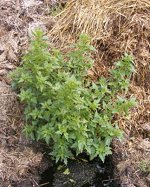
A lot of work has been put into recording this tetrad in an attempt to score more than 100 taxa. I've given up for now at 98!
This is yet another intensive arable agricultural area devoid of woodland, mature hedgerows or established grassland. A short length of the Winestead Drain provided a few aquatic and marginal species including one specimen of Wild Celery (Apium graveolens). A small area noted for a population of Stone Parsley (Sison amomum) had been obliterated by recent dredging operations. Road verges, ditch banks and field entrances again provided the bulk of the banal taxa until I spotted a muck heap, the environs of which boosted the total by 8 including Red Goosefoot (Chenopodium rubrum).
Peter Cook, 22 August 2014
TA12S - Paul Holme
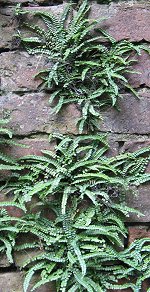
The Humber shore provided an array of saltmarsh halophytes, albeit a little more restricted than would be found in the outer estuary, and the shady brickwork of Paul Fort supported three fern species - Male Fern (Dryopteris filix-mas), Hart's-tongue (Asplenium scolopendrium) and Maidenhair Spleenwort (A. trichomanes). The most interesting area proved to be the sandy ground between the fort and the Humber where several locally scarce plants, including Spiny Restharrow (Ononis spinosa) and Lesser Hawkbit (Leontodon saxatilis), were recorded.
An enjoyable session, fortuitously slotted between two periods of heavy rain, giving a modest total of 141 taxa but providing 34 new records for the hectad to bring it up to 436.
Richard Middleton, 6 August 2014
TA22I - Burstwick
The most 'productive' part of this tetrad is the disused railway track which is pending adoption as a Local Wildlife Site by the East Riding of Yorkshire Council following recent surveys. This list was extended to a total of 177 species by further surveys and was clearly lacking some significant aquatic and marsh species known to occur in and around two large ponds. A visit to "Fenner's pond" and nearby marshy ground was made via the Sangwin works on June 24th with the intention of following this with a visit to "Ski Pond". This requires permission which will now have to wait. Species extra to the 177 already recorded raised the total to 208.
Peter Cook, 4 August 2014
TA05K - Cranswick Common
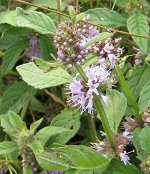
With Corn Mint (Mentha arvensis) as the first plant, my initial enthusiasm was dampened when, after two hours of searching, the list was still well short of 100.
Fortunately a long track and ditch extending along the nothern boundary of the tetrad increased the count to 121 and provided some interesting records including Square-stalked St John's-wort (Hypericum tetrapterum) and Hemp-agrimony (Eupatorium cannabinum).
Richard Middleton, 1 August 2014
SE74V - Seaton Ross
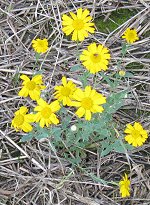
Another unvisited Vale of York tetrad recorded - nothing particularly unusual encountered but a grand total of 150 taxa lifts the hectad total to over 500. There are still some nice arable weeds on the light sandy soil here, with Corn Marigold (Glebionis segetum) found growing abundantly at two sites.
Richard Middleton,
25 July 2014
SE73N - Foggathorpe
Foggathorpe was an unrecorded tetrad in a rather under-recorded hectad. An exhausting visit today in unusually high temperatures (26°) has now given the square a quite respectable total of 173 taxa.
Although nothing extraordinary was encountered the old railway yard provided a good range of plants including Sticky Groundsel (Senecio viscosus) and Small Toadflax (Chaenorhinum minus).
Perhaps the most pleasing find of the day was Pale Buttercup (Ranunculus sardous), a plant more typical of the coast, but encountered here in two places including the village.
Richard Middleton, 22 July 2014
TA03Y - Wawne
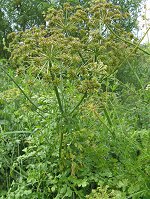
It is somewhat galling when one's home tetrad has yet to meet the 200 taxon "gold" standard. I am pleased to report that work by Rob Atkinson and myself over the last couple of days has lifted the total to a respectable 232. The highlights must be a small group of Pyramidal Orchids (Anacamptis pyramidalis) and a couple of fine Hemlock Water-dropwort (Oenanthe crocata) plants, the latter growing on the very edge of the River Hull. This Water-dropwort is extremely scarce in vc61 and these plants are the only ones currently known along the Hull
Richard Middleton, 9 July 2014
Tectorial Sedum spp.
The growth in popularity of sedum turf roofs has introduced the potential for spread of Sedum spp. as a weed, or at least accusation of such. Recent observations in Withernsea and a few villages in Holderness show that both Sedum anglicum and S. acre became established as roof and guttering weeds long before the local introduction Sedum sp. as a living roof material. I also have my eye on what I think may be S. album and S. rupestre in local villages where, as far as I know, there are no sedum turf roofs. Two sedum roofs have been established during the last 18mths here in Withernsea and I'm not sure which species has/have been used. A quick check of commercially available roofing Sedum spp. shows a large range of both native and non-native species and their cultivars. If these do eventually spread as weeds there will be a new Genus and relatively inaccessible plane of habitat to record! I suggest we periodically raise the level of our gaze and record unidentifiable plants as Sedum sp., for now, for I think we need a baseline dated record of what is/was before there might/will be.
Peter Cook, 5 July 2014
SE96F - Sledmere Field
This tetrad is largely laid down to crops with a minor road running north-south and a green lane running east-west. The latter was lush species-poor grassland flanked on either side by equally poor tall herb. The only mildly exciting finds were in field gateways. A small chalk pit at Life Hill contained nothing conducive to that name. A total of 68 banal species was recorded.
SE96T - Cowlam Grange
This tetrad is dominated by intensive grain and potato production with accessible broad habitats limited to lush, species-poor road verges and a green lane, the latter being the most productive for records. In the NW corner the green lane drops steeply into and out of a gully with Salad Burnet, Fairy Flax, Hoary Plantain and Rock Rose. Phillip's Slack in the SE corner - a task for another day perhaps, with potential for extending recording activity into a chalk-grassland dominated adjacent tetrad. A total of 117 species was recorded.
Peter Cook, 29 June 2014
TA31Y - Humber Bank, Easington
The vc61 local BSBI group met on Saturday 14 June for the first of the year's "formal" excursions. This important tetrad contains a full 2km stretch of coastline which supports a range of saltmarsh, sandy bank and saline marsh environments.
During the course of the afternoon we managed to record 139 taxa, bringing the tetrad total since 2000 up to 168 and the hectad to 222. Among the day's highlights were Rough Clover (Trifolium scabrum) and Knotted Hedge-parsley (Torilis nodosa). Unfortunately the long-established colony of Southern Marsh-orchids (Dactylorhiza praetermissa) was found to have been left sadly depleted after the prolonged saline innundation which arose following last winter's storm surge.
A very enjoyable afternoon was had by all concerned and the marked improvement in the weather was much appreciated by those who had been involved in a Hull "Bioblitz" during the grey morning drizzle.
Richard Middleton June 2014
TA33 "finished" - for now.
TA33 Addendum (so soon!)
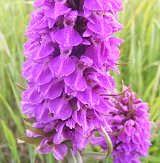
Within 24 hours of posting news of 'finishing' TA33 - admittedly, "for now" - I received an e-mail from Mr Bill Dolling following his recent visit to a tiny patch of grass where he had found 70 spikes of Dactylorhiza purpurella intermingled with a few D. fuchsii and other species new to TA33B, notably Senecio erucifolius. I went to photograph the orchids on 11th June and passed a field of barley infested with a dense swathe of Rye Brome, (Bromus secalinus) along the headlands. Clearly one must always keep looking! One orchid spike was exceptionally large on a very robust plant.
Peter Cook 11 June 2014
The York Bramble (Rubus eboracensis)
The York Bramble is on our latest vc61 card (Rubus ebor). I'm not really into batology (the study of brambles) but this one I do know, and I have started to record it now that it is in leaf and flower. To obviate battology (needless repetition) I refer you to the British Wildflowers website for a helpful pictorial description.
Peter Cook June 2014
SE95V - Cawkeld
I spent several hours on Wednesday in this tetrad for which we have no records since 2000. Much of it was unremarkable - largely planted with peas - and had minimal or no hedges at the field boundaries. The area around Cawkeld was much more interesting and a rather nice ditch opposite Wedding Wood had Primroses, abundant Hairy St John's-wort and Carex otrubae.
The northern boundary ditch of Wedding Wood had a few plants of Hart's-tongue (above), not a rare plant in the vice-county but more usually met with on brick walls.
128 records added to the database from this visit with 19 new hectad records.
Richard Middleton May 2014
TA23F - Lelley Grange
TA23K - Burton Pidsea
TA23P - Aldbrough
Over the summer Bill Dolling has made surveys of these neglected Holderness tetrads bringing each up into the 100 - 200 taxa category. Although these seem poor totals by the standards of the Wolds or even urban Hull, they are a true reflection of the low diversity in these arable Holderness tetrads. The coastal Aldbrough tetrad shows some promise of further taxa and more work is planned for next year.
9 October 2014
SE63L - Osgodby and Lund
An August survey of this previously un-recorded tetrad by Gabrielle Jarvis and Sonia Donaghy has produced a list of just over 150 taxa. A very useful contribution to this under-recorded part of the vice-county.
8 September 2014
SE84W - Goodmanham
Two recent survey visits by Gabrielle Jarvis have boosted the species count of this botanically interesting tetrad to an impressive 254.
29 August 2014
SE85S - West Field, Huggate
Judging from the map I expected this tetrad to be species rich, perhaps even topping the "gold-standard" of 200 taxa. Situated at the head of Pasture Dale with a nice section of Access Land, a section of the Wolds Way and wide roadside verges, it looked perfect. Perhaps it is. Unfortunately the tail end of August is not the time to see it at its best - dried-up grassland, mown verges and sprayed/harvested crops. The total of 102 species was only achieved after a misguided resolution not to leave before the hundred mark!
Fortunately the monotony was relieved by a fine display of three Scabiouses (Knautia arvensis, Scabiosa columbaria & Succisa pratensis), growing together at the dale head, and a large patch of non-flowering Bloody Crane's-bill (Geranium sanguineum) at the roadside. The meagre tetrad total raised the hectad count by exactly 0 - I suspect it needs another visit next June.
Richard Middleton, 26 August 2014
TA21Z - Fisherman's Channel
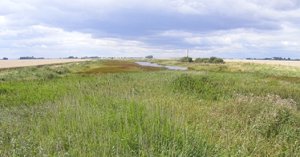
In this tetrad there is proof (see above) that not the whole of the Sunk Island region can be represented by a digestive biscuit. Fisherman's Channel is an inland body of brackish water with dense marginal reed bed and marsh. It is connected to the Humber via the Spragger Drain. Road verges, ditch banks, open areas around farm buildings and field gateways each contributed mainly banal species in ruderal and tall herb communities. The water column and margin of Fisherman's Channel was disappointing in its species diversity although access to open water for sampling was difficult. A pre-2000 record for Ruppia maritima was not re-discovered. The total number of species at 103 is rather higher than found in some other TA21 tetrads.
Peter Cook, 20 August 2014
TA21U - Sunk Island
This tetrad is dominated by intensive agriculture with monocultures of weed-free grain crops intersected by ditches with manicured banks and roads with shaven verges. The species count was not expected to exceed 100 and did not. It probably never will. Approximately half of the total of 83 taxa was found in the cemetery, a veritable oasis, with Slender Speedwell (Veronica filiformis) and Sweet Violet (Viola odorata) as the most significant finds in this very rural location.
Peter Cook, 6 August 2014
TA22X - Winestead
Recent surveys of potential Local Wildlife Sites (LWS) had provided a list of species but there were glaring gaps in some major plant groups and in species of other broad habitats e.g. road verge, arable field margin and disturbed ground, hedgerow and aquatics. There was a notable absence of common archaeophytes so a 2-hour trudge along the verge of the A1033 and a revisit of a section of disused railway track, with occasional forays into field margins, attempted to address this imbalance, with some success. A total of 112 taxa were recorded including 49 additional to the existing 180 for the tetrad. Apart from some unusual species recorded in one of the LWS surveys there were no surprises. Narrow-leaved Meadow-grass (Poa angustifolia) is worth a mention for its persistence along the disused Hull-Withernsea line.
Peter Cook, 5 August 2014
TA22Z - Roos south
My native tetrad into which I visit, on average, twice weekly. There is a churchyard with area left for wildlife; a Victorian plantation over ancient woodland; spring-fed fish pond; woodland planted on remnant fen; fen woodland held as a fox covert; the Keyingham Level Drain and tributaries; road verges, arable field margins and my parent's garden rich in short turf species. With a taxa score of 325 the square is probably 'over-cooked' (pun intended!).
Peter Cook, 1 August 2014
SE87M - Rillington
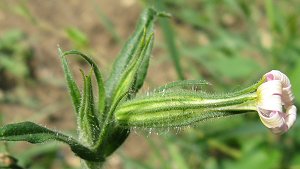
An interesting tetrad in an under-recorded part of the vice-county. The light soils provided some interesting arable weeds, perhaps the best being a single plant of Night-flowering Catchfly (Silene noctiflora) shown above.
In all 169 taxa were recorded but it was well worth the effort as it added 69 to the hectad total - more than 10 times the number of atlas dots generated by a similar sized list last week!
Richard Middleton, 28 July 2014
TA06P - Swaythorpe
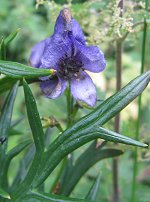
An unremarkable arable tetrad with a total of 131 taxa, the number being helped by a pond just in the north-east corner and a handfull of chalk grassland species in patches along the roadside verges. The most interesting record was a clump of Monkshood (Aconitum napellus) on the Octon Road verge to the south west of Thwing.
This is an uncommon East Yorkshire plant but there is a specimen in the Hull University Herbarium (HLU 381) collected by Prof. Ronald Good from Thwing in 1956 - could this be from the same clump?
Richard Middleton, 15 July 2014
SE63J/SE64E - Haggewoods/Hollicarrs Wood, Escrick
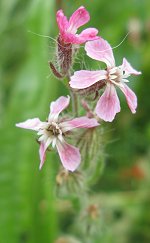
Of particular interest was a single plant of Small-flowered Catchfly or Windmill Pink (Silene gallica) thought not to have been introduced as there are old, local records. Other species regarded as 'residual' were few in number but included Corn Chamomile (Anthemis arvensis) and Annual Beard-grass (Polypogon monspeliensis). Neither of these tetrads were an Action Plan target.
The plantation sites (mainly coniferous) provided evidence of ancient woodland on the field layer with Wood Speedwell (Veronica montana), Wood Sorrel (Oxalis acetosa), Wood Brome (Brachypodium sylvaticum) and Barren Strawberry (Potentilla sterilis) among not previously recorded woodland indicators. In SE63 a total of 107 species was recorded including some residual species in the sown area and a pond. In SE64, consisting mainly plantation with maintained rides and a fish pond, a total of 76 species was recorded.
Peter Cook and Richard Middleton, 08 July 2014
TA13J - Benningholme

An afternoon visit to Benningholme and Skirlaugh has improved the total for this tetrad to 217 - another yellow square on the map. The total was boosted by several "good" records for the notable verge north of Ings Cottages. Along with abundant Saw-wort (Serratula tinctoria) were a few plants of Pepper-saxifrage (Silaum silaus) and Devil's-bit Scabious (Succisa pratensis), pictured above, neither of which has been recorded here for many years.
Richard Middleton, 3 July 2014
TA32A - Patrington Haven
Typical Holderness prairie, estate housing, a holiday chalet park and substantial areas of shaved amenity grassland with zero post-2000 records summarises the broad habitats in this tetrad. An initial recording attempt scored only 51 banal species but a determined effort to access a fragment of disused sand pit at Haverfield via a bridleway traversing the tetrad improved this score. Flanked by barley fields on both sides for the most of the way I found Great Brome (Anisantha diandra or Bromus diandrus now) and the rye-grass hybrid Lolium xboucheanum together with Meadow Brome and Rye Brome (B. commutatus and B. secalinus respectively). However, the real prizes awaited me, as hoped, at Haverfield. A one metre high sandy bank on the western margin with wheat crop was occupied for a distance of at least 100 m by a continuous tangle of Corn Parsley (Petroselinum segetum), Knotted Hedge-parsley (Torilis nodosa), Fern-grass (Catapodium rigidum), remnants of Early forget-me-not (Myosotis ramosissima) and Thyme-leaved Sandwort (Arenaria serpyllifolium). The Corn Parsley used to occur only patchily along this bank but it is now prolific, almost dominant. On the return leg along the top of the bank, Crow garlic (Allium vineale) was a new record for this hectad, and numerous fine grasses and arable weeds boosted the total to a respectable 121, some of which are at their only known station in the hectad. A section of the Winestead drain along the western boundary of the tetrad had recently been dredged and no aquatic or marginal plants have yet re-established.
[Rye (Secale cereale) was noted as a seed contaminant in one field of barley and will be committed to records if it persists (unlikely) - something to watch out for].
Peter Cook 25 June 2014
TA32B - Patrington
A determined "push" was made today (16 June) to access a very limited area of aquatic habitat (one small pond and a ditch) and finally submit the main tranche of records for what is a mainly urban and arable-plain environment with seemingly poor prospect for a high total of species. However, a small nature reserve at the old railway station, remnant railway track, old walls in the village centre, churchyard and cemetery, and farm tracks have all yielded up to the total of 240 species. Worthy of mention is re-finding Pellitory-of-the-wall (Parietaria judaica) on station outbuildings. Snapdragon (Antirrhinum majus) still persists on an old wall near the church where it was first recorded in 1956.
Peter Cook, 16 June 2014
SE95C - Haywold
This tetrad was a sharp reminder of how industrial agriculture on the Yorkshire Wolds can more-or-less obliterate the native chalk flora. Initial hopes were high for this historically under-recorded area with the OS map showing almost 5 km of field paths but after almost three hours of searching the grand total only amounted to 84 taxa, with few of any particular note. Even the roadside verges in this tetrad were species-poor and showed evidence of strict management.
Fortunately the expedition was salvage by a fine clump of Venus's-looking-glass (Legousia hybrida) in a farm gateway opposite where I ate my lunch.
Richard Middleton June 2014
Helleborus viridis: Bishop Wilton
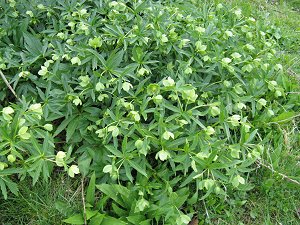
One of the fine clumps of Green Hellebore growing on the bank to the east of Bishop Wilton. Quite an unusual plant in East Yorkshire.
March 2014
TA32H - Hollym Carrs
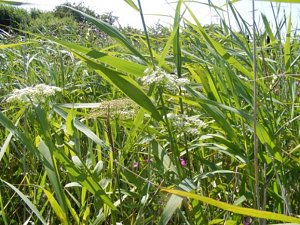
This is a habitat-rich tetrad with green lanes and a disused railway track bed bordering old hedgerows, ditches and arable fields. Part of the tetrad is within the Winestead Carrs National Biodiversity Action Plan Grazing Marsh. The Hollym Carrs Nature Reserve, managed under Higher Level Stewardship by the South Holderness Countryside Society, is a jewel set within a predominantly intensive arable setting. This consists mainly of a woodland plantation set down 20-25 years ago with Alder carr, a meadow reverting from semi-improved pasture to MG4 wet meadow and extensive ponds and associated freshwater marshes. Botanically the reserve is noted for Greater water-parsnip (Sium latifolium) which was first recorded in 1948 and again in 1986, but thereafter disappeared. It has been re-established and is thriving. The Nationally Threatened arable weed Dwarf Spurge (Euphorbia exigua) succumbed to tree planting on the reserve but was re-found this year in the margin of an oilseed rape crop only a few metres from the reserve's boundary. The total number of species, at 295, reflects the recording effort on the reserve since 2000.
Peter Cook, 30 October 2014
TA41D - Long Bank
With Humber estuary salt marsh, flood defence banks and berms; brackish water ditches, ponds and lagoons; beach strandlines, dunes and slacks; both unimproved and improved coastal grassland; road verges and farm tracks; the new Kilnsea Wetlands Nature Reserve and the long-established Beacon Lagoons SSSI, this tetrad is habitat-rich. It has had several Phase I and NVC surveys in the last few years and most of the land area is protected by various conservation designations. With a total of 282 taxa including the vc61 rarities Sea Rush (Juncus maritimus), Frog Rush (J. ranarius), Spiral Tasselweed (Ruppia cirrhosa), Narrow-leaved Bird's-foot Trefoil (Lotus tenuis), Sea Holly (Eryngium maritimum), Sea Pearlwort (Sagina maritima) and Prickly Saltwort (Salsola kali), this is an important tetrad.
Peter Cook, 10 September 2014
SE63N - Skipwith Common
The species count of this important tetrad has been raised to a more respectable 216 with records contributed by local groups. Hull Natural History Society visited on the 17th August this year and Gabrielle Jarvis has provided lists made by the East Yorkshire Botany Club during their visits in 2008 and 2012.
30 August 2014
TA71M - Speeton
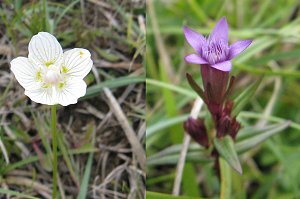
Speeton was a partially-recorded tetrad that had produced some good records from the slumped cliffs, which are liberally irrigated with calcareous seepages. Today's star plant was undoubtedly Grass-of-Parnassus (Parnassia palustris) which was found scattered in good quantity along with Autumn Gentian (Gentianella amarella) and Small Scabious (Scabiosa columbaria).
The arable cliff-top section was rather tame by comparison but did manage to boost the tetrad total to a useful 160. A notable highlight here was Corn Marigold (Glebionis segetum) which occurred in scattered clumps around a large wheat field.
Richard Middleton, 22 August 2014
TA21P - Crown Farm
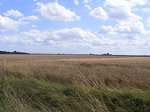
This is the middle one of five previously unrecorded tetrads spanning the hectad in which wheat meets sky. Searches at two field entrances, a road verge and a ditch bank yielded 47 taxa. A tiny portion of the tetrad 'overhangs' the Humber flood defence bank which would yield no more than the same few salt marsh species noted in adjacent tetrad TA21J. An ecological 'hot-spot' consisted cleavers (Galium aparine) and a nettle (Urtica dioica) hiding under a solitary wild privet (Ligustrum vulgare). Black grass (Alopecurus myosuroides) is a troublesome weed in this corner of vc61 and the photograph has caught a line of both dehisced stems of black grass and of false-oat at the crop margin, momentarily highlighted by a passing shaft of sunlight.
Peter Cook, 9 August 2014
TA04F - Beverley north
With an existing list of 126 taxa, this seemed an ideal candidate for upgrading to the magical 200 total. An interesting couple of hours through an old lane with woodland relics, a disused railway, salty roadsides and leafy suburbs yielded a list of 158; not bad for the time of year. Unfortunately this only managed to raise the combined total to 190 but still made a considerable improvement. Interesting finds included extensive mats of Least Yellow-sorrel (Oxalis exilis) and Mind-your-own-business (Soleirolia soleirolii) in a quiet cemetery and parent with seedlings of Caper Spurge (Euphorbia lathyris) on a street corner verge.
Richard Middleton, 5 August 2014
TA21J - Stone Creek
This is potentially the most habitat-rich and records-productive of the four yet-unrecorded Sunk Island tetrads. It is bisected by the Humber shore saltmarsh and has a network of ditches and a flood defence bank. After recording around Stone Creek, the walk up the shoreline to Cherry Cob proved little more than a long walk there and back to see how far it was. A track leading to a radar mast provided some short turf/ruderal species but otherwise the habitat and species variety came from corners of arable fields inaccessible by crop-spray boom; a field abandoned to notifiable weeds such as creeping thistle and common ragwort and frequently and severely mown road verges and ditch banks. A trimmed hawthorn monoculture hedge yielded a single Arum maculatum fruiting spike. This was the only surprise encountered on several visits made with determination to accumulate more than 100 species for the tetrad. At 106 taxa this total may be close to the TA21 hectad total!
Peter Cook, 2 August 2014
TA31U - Skeffling
Habitats ranging from urban walls and waste spaces; road verges and pathways alongside arable fields and ditches; a neatly maintained churchyard providing some short-turf species; a flood defence bank providing some established mesotrophic grassland above a freshwater marshy berm; a brackish water borrow-dyke and a 2km stretch of narrow but species-diverse saltmarsh along the Humber yielded a total of 227 taxa. Despite the habitat diversity and species richness I feel there is still much to be found in this tetrad.
Peter Cook, 27 July 2014
TA13V - Preston
Various visits that we have made to this tetrad over the last month have increased the species count from 5 to 172. The small increase made to the taxon total for the hectad indicates that at 569 TA13 is now very well recorded
Richard Middleton & Peter Cook, July 2014
Allerthorpe Common
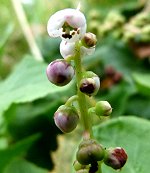
A recent visit to Allerthorpe Common with the East Yorkshire Botany Club has confirmed that some of the more interesting plants are still managing to hold on.
It seems to have been a good year for Broad-leaved Helleborines (Epipactis helleborine) with groups of plants in several places.
This photograph of Common Wintergreen (Pyrola minor) by Sonia Donaghy confirms the plant at its only known East Yorkshire location.
Richard Middleton,
22 July 2014
SE63L - a good start

I am pleased to report that this tetrad with no post 2000 records now has one. A fine Broad-leaved Helleborine (Epipactis helleborine), discovered by Sonia Donaghy, not only starts the recording in style but also provides a new entry for the next edition of the Rare Plant Register.
Richard Middleton,
13 July 2014
TA32N - Withernsea east
My home patch, a hemi-tetrad bisected by the promenade and beach with a diverse mosaic of urban gardens, ten-foots, areas of frequently honed urban green-space, a fishing pond, churchyard and fragments of disused railway brown land providing a higher density of records than the golf course, some arable fields and their margins and caravan parks. Knotted Clover (Trifolium striatum), Sea Mouse-ear (Cerastium diffusum) and Rat's-tail Fescue (Vulpia myuros) are persistent and the most notable of a total now of 256 taxa.
Peter Cook, 10 July 2014
TA31Z - Easington
Beach-cobble walls and some ill-kempt gardens provided variety in this area of mainly intensive agricultural land-use. A long green lane conveniently transects the tetrad north to south providing some old, undisturbed mesotrophic grassland, tall herb, unkempt hedgerow with trees and access into field margins around crops of oilseed rape, wheat and barley. The north-eastern part of the tetrad is occupied by a gas terminal with recently sown artificial meadow areas. A notable re-find was Black Spleenwort (Asplenium adiantum-nigrum) in the mortar of a cobble wall, and Greater Burnett (Sangisorba officinalis) occurring totally out of context, probably having wisely escaped from an overly synthetic meadow dominated by Shasta-sized ox-eye daisies. A total of 208 species was recorded.
Peter Cook, 6 July 2014
TA73C - Breighton
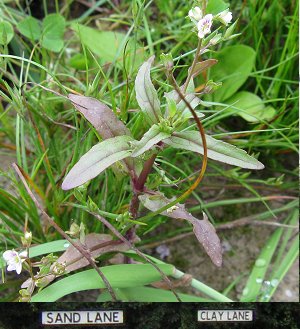
Veronica catenata)
This Derwent valley tetrad proved to be extremely interesting with a good range of habitats. The most striking section was a footpath which ran through Breighton Meadows where there was a wealth of unusual taxa. It is rare to see such quantities of Meadow Barley (Hordeum secalinum) mixed in with Marsh Stitchwort (Stellaria palustris), Marsh Ragwort (Senecio aquaticus) and other plants scarce in the eastern side of the vice-county.
In all 180 species were recorded adding 54 new dots for TA73 to the atlas and four entries in the rare plant register.
Richard Middleton, 27 June 2014
TA04K - Swine Moor
In an attempt to mix business and pleasure I took the opportunity to look at the south-west quadrant of this tetrad in the hour and a half or so needed to have my car MOTed at the dealer's on Swinemoor Lane, Beverley. The industrial and residential areas provided quite a contrast to the neutral grassland which covers much of the tetrad and the list of 130 taxa added 45 new plants, pushing the tetrad into the "yellow" category with 242.
It was mainly plants that would be expected in such an environment but the Small Toadflax (Chaenorhinum minus
) was a nice find and it was good to see White Bryony (Bryonia dioica) scrambling through the hedges in a couple of places.
Richard Middleton, 24 June 2014


















